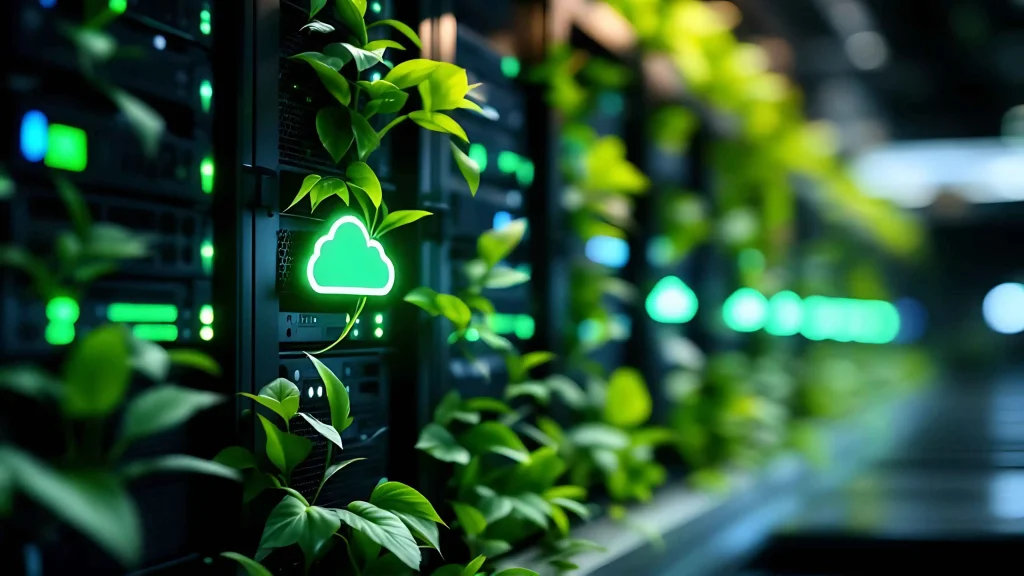Posted by Keyss
The Green Cloud Revolution: How Data Centers Are Going Carbon-Neutral
As AI workloads, cloud adoption, and digital transformation scale exponentially, the world’s data centers — the invisible backbone of our connected lives — are consuming more power than ever before.
In 2025, global data centers are estimated to use nearly 3% of total electricity, rivaling the aviation industry in carbon emissions.
With the rapid rise of AI training workloads, multi-GPU clusters, and always-on cloud services, sustainability is no longer an afterthought — it’s a core innovation driver.
Welcome to the Green Cloud Revolution — where hyperscalers like Google, Amazon Web Services (AWS), and Microsoft Azure are reengineering the infrastructure of the digital world to be carbon-neutral, renewable-powered, and energy-intelligent.
The Challenge: AI and the Energy Equation
AI’s growing power demands are staggering.
Training a single large-scale model, like GPT or Gemini, can consume as much electricity as hundreds of homes use in a year.
Key Drivers of Energy Growth
AI Model Training: Requires high-density GPU clusters and long compute cycles.
Edge Computing Expansion: Billions of IoT devices generating and processing data 24/7.
Always-On Cloud Services: Continuous availability expectations from enterprises and consumers alike.
This has turned energy efficiency and carbon footprint reduction into top-tier business priorities for cloud providers and enterprise IT leaders.
Enter the Green Cloud: Redefining Sustainable Infrastructure
The term “green cloud” refers to cloud infrastructure that minimizes environmental impact through energy-efficient architecture, renewable power, and carbon offset programs.
How It Works:
Renewable Energy Integration: Data centers powered by solar, wind, and hydroelectric grids.
Smart Cooling and Waste Heat Recovery: Using advanced thermal engineering to reduce power consumption.
AI-Based Energy Optimization: Machine learning models predicting and adjusting workloads for energy efficiency.
Carbon Offsets and Circular Design: Investing in carbon-neutral operations and recyclable hardware.
The world’s top cloud providers are now competing not only on performance — but on sustainability.
Google Cloud: The Carbon-Neutral Pioneer
Google became the first major tech company to achieve carbon neutrality back in 2007 — and now aims to operate on 100% carbon-free energy, 24/7, by 2030.
How Google Is Leading:
Custom Renewable Grids: Powering data centers with region-specific wind and solar contracts.
AI-Powered Cooling: DeepMind algorithms cut cooling energy use by 40%.
Carbon Intelligence Platform: Tracks and optimizes workloads based on renewable energy availability in real time.
Google’s “sustainable by design” strategy shows how AI can make AI greener — a virtuous feedback loop of intelligence and efficiency.
AWS: Driving Efficiency at Hyperscale
Amazon Web Services, the world’s largest cloud provider, has committed to running 100% on renewable energy by 2025 — five years ahead of its initial schedule.
AWS’s Green Innovations Include:
Wind and Solar Investments: Over 100 renewable projects globally, generating more than 20 gigawatts of clean energy.
Nitro System and Graviton Chips: Custom-built processors optimized for performance-per-watt efficiency.
Sustainable Data Center Design: Utilizing waterless cooling systems and recycled construction materials.
AWS is also helping customers measure their cloud carbon footprint through the Customer Carbon Footprint Tool, enabling more sustainable cloud migrations.
Microsoft Azure: The Circular Cloud
Microsoft has pledged to be carbon negative by 2030 — meaning it will remove more carbon from the atmosphere than it emits.
Azure’s Sustainable Cloud Commitments:
Circular Data Center Initiative: Reusing and recycling servers, networking components, and racks.
AI-Driven Sustainability: Using predictive algorithms to balance workloads based on renewable power availability.
Advanced Cooling Technologies: Liquid immersion and phase-change cooling for AI training servers.
Through partnerships with governments and enterprises, Azure is pushing toward net-zero cloud infrastructure across global regions.
Cooling Technologies: Innovation Below the Surface
Cooling accounts for nearly 40% of a data center’s total energy use, making it a critical target for innovation.
1. Liquid Immersion Cooling
Instead of relying on fans and air conditioning, servers are submerged in thermally conductive, non-conductive liquids.
This method improves energy efficiency by up to 90% compared to traditional systems.
2. AI-Based Thermal Management
Sensors and ML algorithms dynamically adjust cooling intensity based on workload heat patterns — reducing waste and cost.
3. Geothermal and Underwater Data Centers
Microsoft’s Project Natick demonstrated that underwater data centers can stay naturally cool and operate more efficiently — a glimpse into future large-scale sustainable computing.
Why Sustainability Is a Competitive Edge
Sustainability is no longer just a compliance requirement — it’s a market differentiator.
1. Enterprise Procurement Pressure
Enterprises increasingly demand sustainability disclosures from cloud vendors. Green credentials are influencing RFP decisions and contract renewals.
2. Cost Savings Through Efficiency
Energy-efficient data centers lower operational costs over time, creating financial and environmental ROI.
3. Brand Value and ESG Commitments
Companies with measurable environmental impact are attracting investors and customers focused on ESG (Environmental, Social, Governance) principles.
4. Innovation Catalyst
The pursuit of greener infrastructure drives new materials science, chip design, and AI optimization research — accelerating the next wave of tech advancement.
Conclusion: Building a Sustainable Digital Future
The cloud revolution changed how the world computes.
Now, the green cloud revolution is changing how responsibly we compute.
As AI, cloud workloads, and data demands surge, sustainability is no longer optional — it’s the foundation of long-term digital growth.
Companies that embrace green data centers today aren’t just protecting the planet — they’re securing their competitive future.
The race toward carbon-neutral computing is well underway — and the winners will be those who can deliver intelligence at scale, sustainably.

